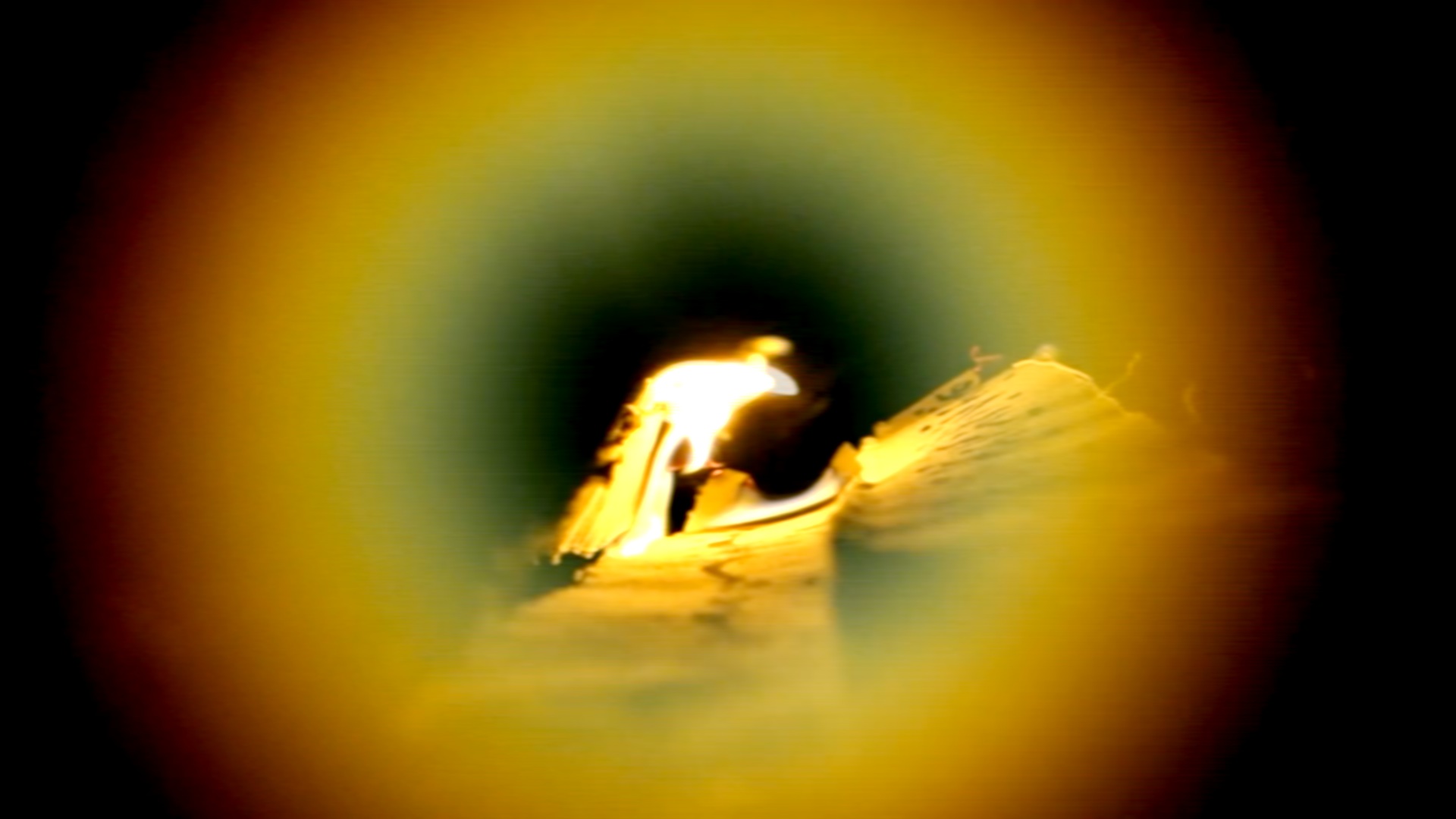presented by San Francisco Cinematheque and San Francisco Museum of Modern Art
in association with theCanyon Cinema Foundation
Admission: $12 general/$10 Cinematheque and SFMOMA members with member code
Advance tickets available on May 1 here.
Join our Facebook event.
Films presented in consideration of closeness and distances, spiritual grace, of intimacies expressed and longed for. Desires for connection are whispered, dreams lamented. Films as love letters sent across space and time. Considerations of the soul—whispered, howled, unspoken and sung.
SCREENING
Prima Materia (2015) by Azin Seraj; digital video, color, sound, 9 minutes, exhibition file from the maker
To the alchemists, the crudest base materials concealed a divine spark, a latent, transformative potential obscured within the darkness of matter. Prima Materia draws on the cryptic language of esoteric alchemy to distill, through the use of elemental processes and symbolically charged objects, both the personal experience and psychological phenomenon of surviving trauma. The calligraphic Farsi inscriptions on three imperfect strips of canvas are repetitive mantras of darkness, loss and regret. A static, glacial wall of ice obscures them—cracked, however, in the process of filming, and embraced as an accidental and apt metaphor for the thaw of dissociation and return of feeling. Flames consume the dark matter of traumatic memory (and nearly the camera in the process), producing a circular halo effect similar to medieval depictions of the chaotic, mythical prima materia. Three voices of Iranian women—recorded live in a chance encounter—act as a trinity of catalysts for the transmutation. Destruction of the narrative transforms and releases it.
If the medicine is contained within the poison, then the process of alchemical transformation becomes its own inherent remedy. The disempowered, vulnerable and wounded parts of the psyche that we deny and distance ourselves from are prima materia—and thereby hold the key to reintegration within their toxicity. Rather than failed or inadequate, they are necessary fuel, the base material of the work. (Azin Seraj)
2076 (Elegy) (2016) by Karly Stark; digital video, color, sound, 6 minutes, exhibition file from the maker
In the year 2076, a cyborg finds moving images made by their great-grandmother in the last years of celluloid. Looking at the images, they are struck by the past, causing them to dig into their own memories, history and identity.
Gleaned from images from the filmmaker's life, 2076 looks at the ways in which familial history and queer identity are communicated through the archive/photographic image. Topically situated as the analog image is quickly disappearing, this film explores its virtues, illustrating the ways in which the past imbues small moments with power and glimpses of our past can speak and serve as catharsis to our present. (Karly Stark)
Feeler (2016) by Paul Clipson; 16mm, color, sound, 7 minutes, print from the maker bay area premiere
An imagining of sounds, music and images, of dreams within dreams, conceived within an evolving series of environments, exploring the world, seeing, hearing and experiencing light, space, movement and sound in emotional juxtapositions. (Paul Clipson)
Blue Movie (2015) by Michael A. Morris; 16mm, color, sound, 7 minutes, print from the maker bay area premiere
Blue Movie is an elegiac tribute to the late Juanita Slusher, a Dallas-based exotic dancer well known in the ‘50s and ‘60s as "Candy Barr." Footage from the stag-film Smart Alec, a film given to me by my grandfather, is used as the majority of the source imagery set to a rendition of “Autumn Leaves” performed by Dallas-based vocalist Lily Taylor. The song was noted by Candy Barr as her favorite to dance to, while also noting that she viewed her dancing as a form of creative expression. The silver-based emulsion of the film was replaced with cyanotype chemistry and laid under the sun to create the blue image.
This film is a companion piece to my 2010 film Confessors. (Michael A. Morris)
Idyll (2014) by Mary Billyou; digital video, color, sound, 6 minutes, exhibition file from the maker bay area premiere
“Fewer families were born, lived, and died in the same place. People, especially young ones, were ready for a new life, as far removed from the old one as possible. Living space was much smaller and there were few, if any, servants. Many wives were working outside the home and leisure was not to be spent doing housework, but in being out of doors as much as possible. Emphasis was on informal living and informal entertaining.” (Interior Decorating with House Beautiful)
Home movies, animated sequences, mattes and xeroxed leader recall a gothic sensibility submerged. Marginal worlds appear briefly amidst the genteel surroundings of family life. Both imaginary and real, questions linger amongst the surface of sameness. (Mary Billyou)
025 Sunset Red (2016) by Laida Lertxundi; digital video, color, sound, 14 minutes, exhibition file from the maker
025 Sunset Red is a kind of quasi-autobiographical reckoning. An indiscernibility of then and now. Recollection and immediacy. Delicacy and virility. The elusive and the haptic. The Basque Country and California. It’s a set of echoes of an upbringing by communist radicals, not as nostalgia but as a way of making sense, of finding practical applications of the past in the present. Within the film, blood is collected and poured, red filters cover landscapes, and images of desire are both produced and observed. The film is a diaphanous, psychedelic foray into the domestic and the political, looking at ways that politics may erupt, shape a life, form a sensibility, and become inscribed upon a body. (Laida Lertxundi)
See a Dog, Hear a Dog (2016) by Jesse McLean; digital video, color, sound, 18 minutes, exhibition file from Video Data Bank
Taking its title from a sound design maxim and using it as a conceit to grasp the desire for connection, this video probes the limits and possibilities of communication. In this liminal cinematic space, the fear of conscious machines is matched with a desire to connect with nonhuman entities. Algorithms collaborate and improvise. Dogs obey/disobey human commands, displaying their own artistry and agency in the process. Technology, from domesticated animals to algorithmic music to chat rooms, reflects human desires but has its own inventiveness. Can we ever truly communicate with a machine, with a nonhuman animal, with each other? Our anthropomorphic tendencies, our fear of replacement by nonhuman forms, even our interpersonal limitations, can’t foreclose the possibility of connection and understanding, a great unknown sometimes called trust. (Jesse McLean)
With YouTube dog videos, chatbot dialogue windows, and iTunes visualizer among other sources, See a Dog, Hear a Dog—McLean’s latest analytic tragicomedy of infinite human desire and finite technological capacity—considers the deficits and surpluses produced by attempts at communication among humans, animals, and machines; both directly and as mediated by one another. (Colin Beckett)
Pictured above: Prima Materia (2016) by Azin Seraj
CROSSROADS 2017 is generously supported by: National Endowment for the Arts, Fleishhacker Foundation, Grants for the Arts, Zellerbach Family Foundation, George Lucas Family Foundation, Owsley Brown III Philanthropic Foundation and the Willow Foundation.
With thanks to our festival sponsors:

